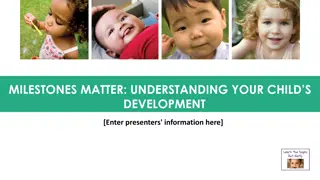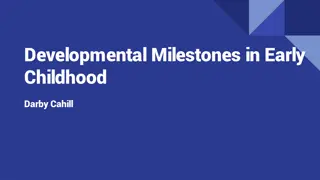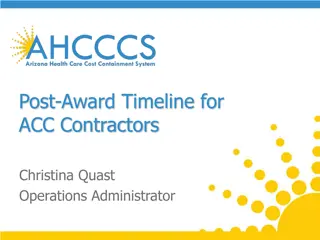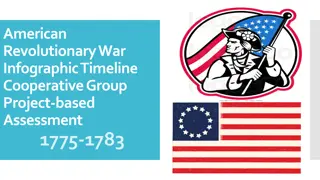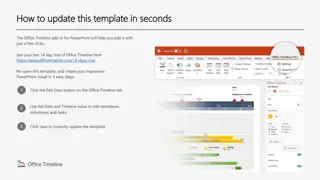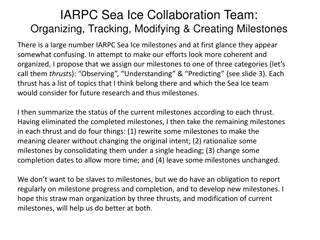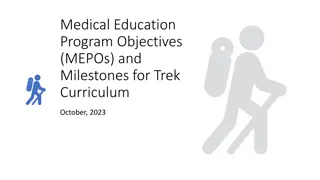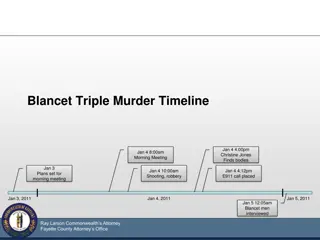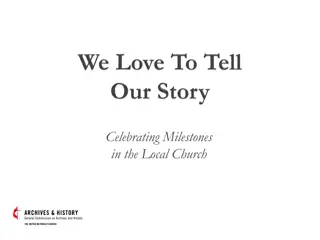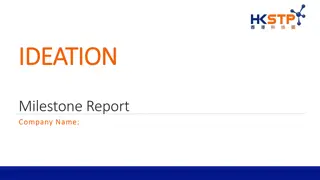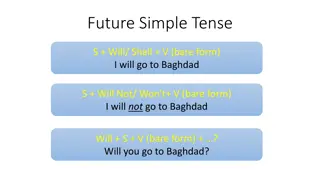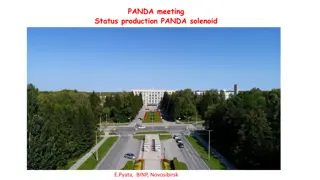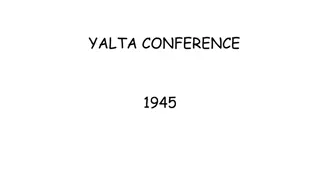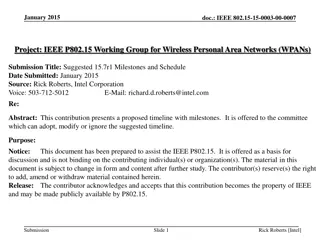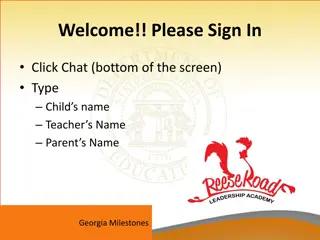KORUS-AQ Timeline of Significant Events and Future Milestones
NCAR scientists explore the possibility of an aircraft experiment in Korea leading to the formation of KORUS-AQ. Collaborative efforts, meetings, and preparations are made over several years, culminating in the finalization of the International Agreement and deployment plans. The timeline showcases the progress and cooperation between US and Korean scientists in the field of air quality research.
Download Presentation

Please find below an Image/Link to download the presentation.
The content on the website is provided AS IS for your information and personal use only. It may not be sold, licensed, or shared on other websites without obtaining consent from the author. Download presentation by click this link. If you encounter any issues during the download, it is possible that the publisher has removed the file from their server.
E N D
Presentation Transcript
KORUS-AQ Timeline of Significant Events and Future Milestones May 2010 NCAR scientists visit several sites and institutions and begin thinking about the possibility of an aircraft experiment NCAR-NIER collaborative observation at Taehwa Research Forest initiated NASA & NCAR visit to Korea and discussion of common interests and respective capabilities with scientists at NIER Korean visitors including an official from the Ministry of Environment visit Houston for DISCOVER-AQ to see a field study in action and discuss common interests for a study in Korea Town Hall at Fall AGU meeting to gauge community interest in an air quality study working with Korea A preliminary rationale document is completed to articulate the merits of an air quality study in Korea with details on how the US and Korea might cooperate Second visit to Korea, Steering Group is formed; KORUS-AQ name is adopted; visit to Osan airbase 2011 September 2012 September 2013 December 2013 January 2014 May 2014
KORUS-AQ Timeline of Significant Events and Future Milestones November 2014 December 2014 January 2015 February 2015 April 2015 Initial draft of International Agreement finalized by NASA and transmitted to State Department US and Korean White Papers completed by the KORUS-AQ Steering Group and made available online Biweekly webex discussions between US and Korean Steering Group members begin KORUS-AQ Solicitation for proposals issued in ROSES 2015 NASA sends scientists to Korea for early installation of Pandora spectrometers and Aeronet sunphotometers at 6 field sites to collect observations in advance of the 2016 field study International Agreement returned from State Department with minimal comment and forwarded to Korea KORUS-AQ due date for proposals on 15th (66 proposals submitted) Korean colleagues conduct a pre-campaign of ground observations and King Air research flights May 2015 May 2015 May/June 2015
KORUS-AQ Timeline of Significant Events and Future Milestones June 2015 Third visit to Korea; Steering Group finalizes deployment dates (1 May 15 June 2016); meetings at Osan airbase demonstrate basic feasibility and the decision to base the research aircraft there is finalized KORUS-AQ Panel Review convenes; Korean scientists participate as both reviewers and observers KORUS-AQ Science Team selections announced (23 proposals selected) Korea accepts final language of the International Agreement (MOU) KORUS-AQ Science Team meeting at NASA LaRC, signed MOU delivered July 2015 August 2015 September 2015 October 2015
KORUS-AQ Timeline of Significant Events and Future Milestones December 2015 January 2016 March-April 2016 May-June 2016 Convene AGU sessions and meet to discuss progress in field study plans Visit Air Traffic Control authorities in Korea to discuss flight plans Aircraft integration (DC-8 and LaRC King Air) KORUS-AQ Field Deployment (120 research flight hours for each aircraft)
Scientific rationale and the unique value of a Korean study Satellite observability of air quality Including integration with models and ground monitoring networks Validation strategy testbed with benefits to GEO (TEMPO, GEMS, Sentinel-4) and LEO (Sentinel-5 precursor) missions
Global Pollution Monitoring Constellation (2018-2020) Sentinel-4 (hourly) TEMPO (hourly) GEMS (hourly) Sentinel-5P (once per day) Courtesy Jhoon Kim, Andreas Richter Policy-relevant science and environmental services enabled by common observations Improved emissions, at common confidence levels, over industrialized Northern Hemisphere Improved air quality forecasts and assimilation systems Improved assessment, e.g., observations to support United Nations Convention on Long Range Transboundary Air Pollution 6
Scientific rationale and the unique value of a Korean study Satellite observability of air quality Including integration with models and ground monitoring networks Validation strategy testbed with benefits to GEO (TEMPO, GEMS, Sentinel-4) and LEO (Sentinel-5 precursor) missions Megacity environment Model evaluation of Emissions, Chemistry, Transport Seoul Metropolitan Area (SMA) ranked as 2nd largest metropolitan area worldwide SMA includes approx. 50% of Korean population MODIS land cover map of South Korea. Red colors denote urban and built-up areas, greens are forests, and gray indicates croplands (courtesy Christine Wiedinmyer).
Scientific rationale and the unique value of a Korean study Satellite observability of air quality Including integration with models and ground monitoring networks Validation strategy testbed with benefits to GEO (TEMPO, GEMS, Sentinel-4) and LEO (Sentinel-5 precursor) missions Megacity environment Model evaluation of Emissions, Chemistry, Transport Seoul Metropolitan Area (SMA) ranked as 2nd largest metropolitan area worldwide SMA includes approx. 50% of Korean population Anthropogenic/Biogenic Mixtures Sharp transition between SMA and surrounding rural areas provides opportunities to target specific urban/rural mixtures and discern impacts on secondary pollution formation (ozone and aerosols)
This typical ozone isopleth diagram shows the nonlinear response of ozone production to mixtures of NOx and hydrocarbons. The diversity of mixtures occurring across the Seoul Metropolitan Area (NOx and VOC sources) and downwind (BVOC sources) provide an ideal natural laboratory to examine a broad range of mixtures.
Scientific rationale and the unique value of a Korean study Satellite observability of air quality Including integration with models and ground monitoring networks Validation strategy testbed with benefits to GEO (TEMPO, GEMS, Sentinel-4) and LEO (Sentinel-5 precursor) missions Megacity environment Model evaluation of Emissions, Chemistry, Transport Seoul Metropolitan Area (SMA) ranked as 2nd largest metropolitan area worldwide SMA includes approx. 50% of Korean population Anthropogenic/Biogenic Mixtures Sharp transition between SMA and surrounding rural areas provides opportunities to target specific urban/rural mixtures and discern impacts on secondary pollution formation (ozone and aerosols) Transboundary pollution Local sources versus upwind along the Pacific Rim Evaluate transport efficiency, removal rates, deposition impacts Surrounding waters serve as a buffer to isolate upwind from local sources Numerous upwind megacities, e.g., Beijing and Shanghai Opportunity to confirm Asian emission trends via comparison with previous airborne campaigns
Example of the distribution of tropospheric NO2 over Asia. (http://www.temis.nl/airpollution/no2.html) Mean annual tropospheric NO2 column densities detected by the GOME and SCIAMACHY satellites show large relative changes in NO2 over China from 1996-2011. (taken from Hillbol et al., 2013)
Scientific rationale and the unique value of a Korean study Satellite observability of air quality Including integration with models and ground monitoring networks Validation strategy testbed with benefits to GEO (TEMPO, GEMS, Sentinel-4) and LEO (Sentinel-5 precursor) missions Megacity environment Model evaluation of Emissions, Chemistry, Transport Seoul Metropolitan Area (SMA) ranked as 2nd largest metropolitan area worldwide SMA includes approx. 50% of Korean population Anthropogenic/Biogenic Mixtures Sharp transition between SMA and surrounding rural areas provides opportunities to target specific urban/rural mixtures and discern impacts on secondary pollution formation (ozone and aerosols) Transboundary pollution Local sources versus upwind along the Pacific Rim Evaluate transport efficiency, removal rates, deposition impacts Surrounding waters serve as a buffer to isolate upwind from local sources Numerous upwind megacities, e.g., Beijing and Shanghai Opportunity to confirm Asian emission trends via comparison with previous airborne campaigns
NASAs Atmospheric Composition Goals emphasize Progress in understanding and improving predictive capability for changes in the ozone layer, climate forcing, and air quality associated with changes in atmospheric composition.
KORUS-AQ will combine assets from the Korean and U.S. atmospheric scientists communities and their supporting organizations (NIER, NASA, Universities, etc.) to implement an integrated observing system for improving our understanding of Air Quality GOCI, OMI, MODIS, CALIPSO, IASI, etc. Model evaluation and improvement, chemical process understanding, GEMS validation and observing strategies NASA DC-8 NASA King Air Hanseo King Air KMA King Air Operational Air Quality Forecasts, Regional and Global models of atmospheric composition Air Quality Network, Research Sites, Research Vessels including in situ and remote sensing observations (lidar, Aeronet, Pandora)


